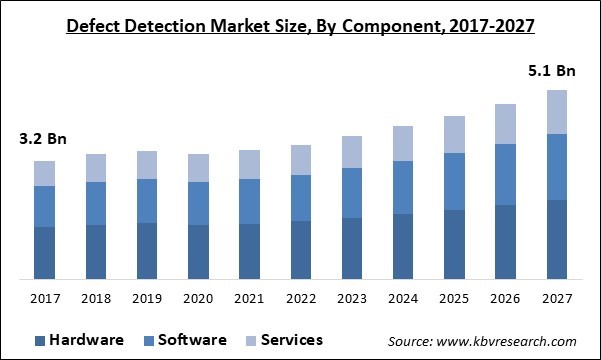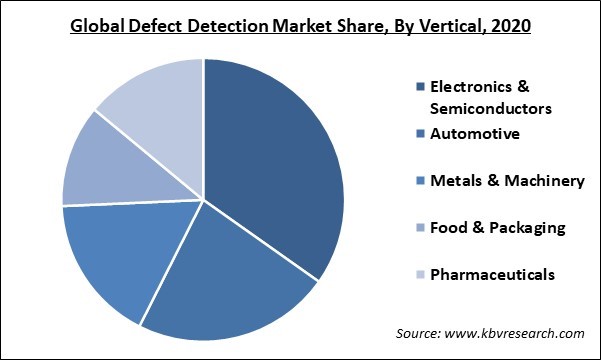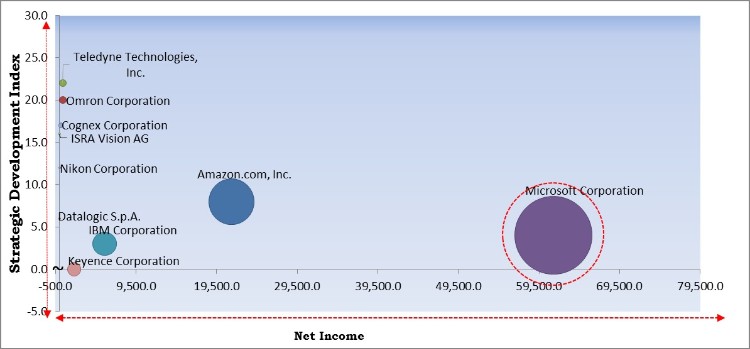The Global Defect Detection Market size is expected to reach $5.1 billion by 2027, rising at a market growth of 6.6% CAGR during the forecast period.
During the manufacturing procedures of mechanical products, some levels of defects are unavoidable. These defects may involve unwanted holes, abrasions, pits, and scratches on several parts that go out from the assembly line. Defects could begin from design failures, erroneous production device, metal fatigue and non-supportive working conditions or any inter-connection between these factors.
Defect detection has become highly technology-driven, based on the constant developments in big data and artificial intelligence. The utilization of smart cameras and associated AI-driven systems is already assisting manufacturers to provide super quality examination in shorter cycles, decreasing latency and costs, and establishing new mandates that are not feasible to be performed even by highly experienced human inspectors.
The Electronics & Semiconductors market dominated the Global Defect Detection Market by Vertical 2020, and would continue to be a dominant market till 2027; thereby, achieving a market value of $1,693 million by 2027. The Automotive market is exhibiting a CAGR of 6.2% during (2021 - 2027). Additionally, The Metals & Machinery market is poised to grow a CAGR of 6.9% during (2021 - 2027).
The Manufacturing market dominated the Global Defect Detection Market by Application 2020, and would continue to be a dominant market till 2027; thereby, achieving a market value of $2,856.9 million by 2027. The Packaging market experiencing a CAGR of 7.8% during (2021 - 2027).
The Global Defect Detection Market attained a market size of $3,394.6 million 2020 and it is expected to reach $5,113.4 million by 2027, growing at a CAGR of 6.6% during 2021 -2027.
Hence, defect detection is a major component of any manufacturing quality control and assurance processes. Conventionally, defect detection was performed manually by human beings who are highly susceptible to fatigue, biases, and inattentiveness. However, currently manual inspection is enhanced by rule-based machine vision technologies.

The outbreak of the COVID-19 pandemic has disrupted the global demand and supply chain. The imposition of complete or partial lockdown across various developing nations in the world, especially China has negatively impacted the growth of various industries.
Moreover, the defect detection components made by these companies are bought by various stakeholders for different business verticals. In addition, the outbreak of the COVID-19 pandemic has negatively impacted the defect detection. This is attributed to the fact that defect detections systems are utilized by manufacturing facilities in order to detect any manufacturing fault in the final products.
There are numerous advantages of AI-based defect detection for the manufacturers. The major benefits of these systems are declined labor and other operational costs. Conventionally, defect detection was performed manually with the help of human inspection.
Moreover, higher production volume without hampering the quality of the products would open new growth avenues for the defect detection market during the forecast period. Furthermore, early error detection prevents faulty parts to go forward on the production line which would propel the market growth.
In manufacturing, there should be an ideal balance between maximizing yield and bringing down the number of defective components, which is feasible through deploying quality control processes. In addition, this balance is hard to strike and is extremely relied on the industry and the manufacturing methods applied.
Manufacturers are aggressively moving to adopt automation technologies with an aim to optimize resources, bring down operating & maintenance costs, avoid quality defects, and maintain superior quality of products. In addition, process as well as discrete industries have shifted to follow the best practices in order to decrease wastage and boost plant efficiency.
In the manufacturing sector, there is a massive dependency on human experience and human senses. Though, the less availability of qualified professionals has become a major problem; hence, automation of manufacturing, assembly, product testing and inspection, and transportation processes that depend on people has become an urgent task for businesses.
As a result, businesses across different industries adopt industrial automation with the rising utilization of defect detection systems, machine vision systems, and others to drive up operational efficiency and performance, bring down waste and conserve natural resources, and enter new markets and audiences, but factories accepting machine vision technology would need more advanced skill sets, and it may be hard for less/semi-skilled, less-educated workers to access opportunities.

Based on Offering, the Defect Detection market is segregated into Hardware, Software, and Services. Software segment is likely to showcase the highest growth rate during the forecasting period. This is attributed to the increase in focus on automating quality control and assurance processes, and incorporation of deep learning and AI technology in defect detection systems. Conventional software and deep learning software are included in the software type.
Based on Application, the Defect Detection market is segmented into Manufacturing and Packaging. Manufacturing application segment would showcase the highest growth rate during the forecast period. The defect detection is required by the manufacturing application in order to identify cosmetic defects on different sorts of surface, which are hard to inspect with traditional rule-based machine vision algorithms and human eye.
Based on Vertical, the Defect Detection market is divided into Automotive, Electronics & Semiconductors, Metals & Machinery, Food & Packaging, and Pharmaceuticals. Electronics & semiconductors segment would showcase the highest growth rate in the defect detection market during the forecasting period. The growth of the segment is attributed to the surge in demand for high-speed assembly inspection where the throughput of parts is quick and increasing requirement to adhere to strict quality standards.
| Report Attribute | Details |
|---|---|
| Market size value in 2020 | USD 3.4 Billion |
| Market size forecast in 2027 | USD 5.1 billion |
| Base Year | 2020 |
| Historical Period | 2017 to 2019 |
| Forecast Period | 2021 to 2027 |
| Revenue Growth Rate | CAGR of 6.6% from 2021 to 2027 |
| Number of Pages | 241 |
| Number of Tables | 363 |
| Report coverage | Market Trends, Revenue Estimation and Forecast, Segmentation Analysis, Regional and Country Breakdown, Competitive Landscape, Companies Strategic Developments, Company Profiling |
| Segments covered | Offering, Application, Vertical, Region |
| Country scope | US, Canada, Mexico, Germany, UK, France, Russia, Spain, Italy, China, Japan, India, South Korea, Singapore, Malaysia, Brazil, Argentina, UAE, Saudi Arabia, South Africa, Nigeria |
| Growth Drivers |
|
| Restraints |
|
Based on Region, the Defect Detection market is analyzed across North America, Europe, APAC, and LAMEA. The APAC region is expected to display the highest growth rate over the forecast period. Emerging countries of this region like India, China, South Korea, and Japan have some of the biggest manufacturing units, and these facilities are well equipped with automation.
Free Valuable Insights: Global Defect Detection Market size to reach USD 5.1 billion by 2027

The major strategies followed by the market participants are Product Launches. Based on the Analysis presented in the Cardinal matrix; Microsoft Corporation is the major forerunners in the Defect Detection Market. Companies such as Omron Corporation, Cognex Corporation, Datalogic S.p.A. are some of the key innovators in the Market.
The market research report covers the analysis of key stake holders of the market. Key companies profiled in the report include Microsoft Corporation, IBM Corporation, Amazon.com, Inc., Omron Corporation, Cognex Corporation, Datalogic S.p.A. (Hydra S.p.A.), Nikon Corporation, Keyence Corporation, Teledyne Technologies, Inc., and ISRA Vision AG (Atlas Copco).
By Component
By Application
By Vertical
By Geography
The Defect Detection market size is projected to reach USD 5.1 billion by 2027.
Advent of AI-based defect detection systems are driving the market in coming years, however, Less availability of experts in manufacturing activities limited the growth of the market.
Microsoft Corporation, IBM Corporation, Amazon.com, Inc., Omron Corporation, Cognex Corporation, Datalogic S.p.A. (Hydra S.p.A.), Nikon Corporation, Keyence Corporation, Teledyne Technologies, Inc., and ISRA Vision AG (Atlas Copco).
The expected CAGR of the Defect Detection market is 6.6% from 2021 to 2027.
The Electronics & Semiconductors market dominated the Global Defect Detection Market by Vertical 2020, and would continue to be a dominant market till 2027; thereby, achieving a market value of $1,693 million by 2027.
Our team of dedicated experts can provide you with attractive expansion opportunities for your business.

